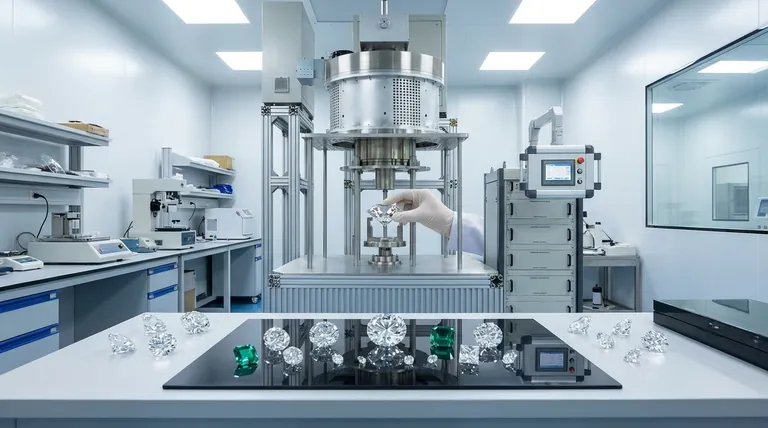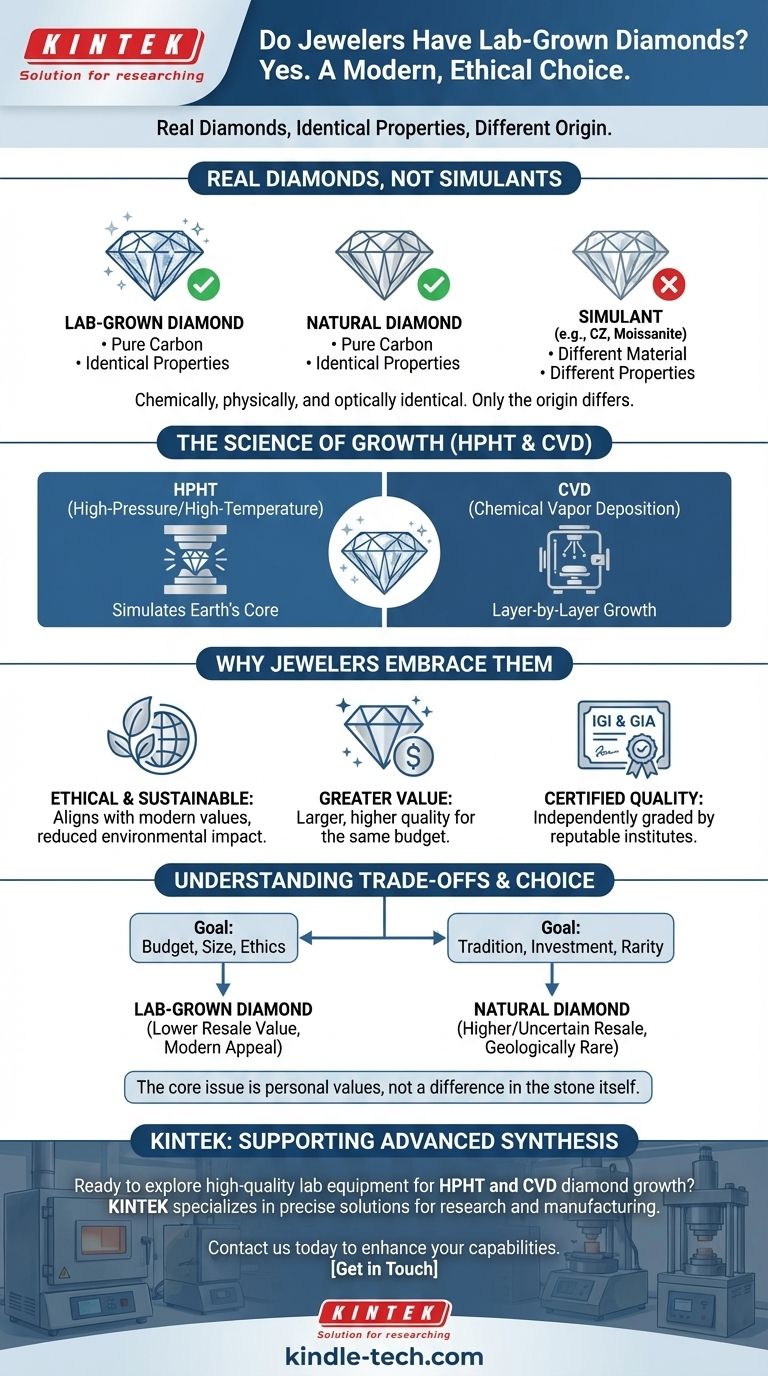Yes, a significant and growing number of jewelers now carry lab-grown diamonds. This includes some of the world's largest jewelry brands, which have embraced them as an ethical and more affordable alternative to mined diamonds. These are not fakes or simulants; they are real diamonds, identical in every physical, chemical, and optical way to those formed in the earth.
The core issue is no longer about availability, but about understanding. Because lab-grown diamonds are physically identical to natural diamonds, the choice between them comes down to personal values, budget, and long-term expectations—not a difference in the stone itself.

What Exactly Is a Lab-Grown Diamond?
To make an informed decision, you first need to understand what you are buying. The term "lab-grown" is a precise description of the diamond's origin, not its quality or composition.
A Diamond's Origin, Recreated
Scientists use advanced technology to replicate the natural diamond-growing process. The two primary methods are High-Pressure/High-Temperature (HPHT) and Chemical Vapor Deposition (CVD).
Both methods start with a tiny diamond "seed" and create an environment where carbon atoms can attach to it, growing a new diamond layer by layer. The result is a true diamond.
Identical in Every Measurable Way
The most critical takeaway is this: a lab-grown diamond is chemically, physically, and optically identical to a mined diamond. They have the same hardness, brilliance, and fire.
The only difference is their origin. One was formed deep within the Earth over billions of years, while the other was created in a highly controlled laboratory environment over a few weeks.
Not a Simulant or "Fake"
It's crucial to distinguish a lab-grown diamond from a diamond simulant. Materials like moissanite or cubic zirconia look like diamonds but are not chemically the same.
A lab-grown diamond is a diamond. A simulant is a different material entirely, with different physical properties.
Why Major Jewelers Have Embraced Them
The shift toward lab-grown diamonds in the jewelry industry isn't a fad; it's a response to fundamental market changes and technological advancements.
Responding to Modern Values
Many consumers are increasingly concerned about the environmental impact and ethical questions surrounding diamond mining. Brands like Pandora have shifted entirely to lab-grown diamonds to address these concerns directly.
Offering Greater Value
Without the massive costs of mining, lab-grown diamonds can be sold for significantly less than their natural counterparts. This allows a buyer to purchase a larger or higher-quality stone for the same budget.
Ensuring Quality Through Certification
Reputable lab-grown diamonds are graded and certified by the same gemological institutes that grade mined diamonds, including the International Gemological Institute (IGI) and the Gemological Institute of America (GIA).
This independent certification ensures the diamond's quality characteristics (cut, color, clarity, and carat weight) are accurately stated, giving you confidence in your purchase.
Understanding the Trade-offs
Choosing a lab-grown diamond involves weighing a different set of considerations. Being aware of them allows you to make a choice that aligns with your priorities.
The Question of Resale Value
The long-term resale value of lab-grown diamonds is still uncertain and is generally expected to be lower than that of natural diamonds. As technology improves, the cost to produce them continues to fall.
This makes them an excellent choice for personal value and adornment but a less certain vehicle for financial investment compared to a high-quality natural stone.
The "Rarity" Factor
By their nature, lab-grown diamonds are not geologically rare. Their value comes from the technology and energy required to produce them.
For those who place a high value on the mystique and history of a stone formed billions of years ago, a mined diamond will always hold a unique appeal. For others, the modern origin story is a feature, not a drawback.
The Certification Landscape
While GIA provides reports for lab-grown diamonds, you will more commonly find them certified by IGI. Both are highly respected labs. The key is not which specific lab graded the stone, but that it has been independently graded by a reputable organization.
Making the Right Choice for Your Goal
Your decision should be guided by your primary objective for the purchase.
- If your primary focus is maximizing size and quality for your budget: A lab-grown diamond is the logical and undisputed choice.
- If your primary focus is tradition and potential long-term value retention: A natural diamond with a top-tier GIA certificate may better align with your goal.
- If your primary focus is minimizing environmental and ethical impact: A lab-grown diamond offers a clear and verifiable advantage.
Ultimately, choosing a lab-grown diamond means selecting a beautiful, durable, and authentic stone, distinguished only by its modern origin and accessible price point.
Summary Table:
| Aspect | Lab-Grown Diamond | Natural Diamond |
|---|---|---|
| Chemical Composition | Identical (Pure Carbon) | Identical (Pure Carbon) |
| Physical Properties | Identical (Hardness, Brilliance) | Identical (Hardness, Brilliance) |
| Primary Appeal | Ethical, Affordable, Larger Size | Tradition, Perceived Rarity |
| Resale Value | Lower / Uncertain | Generally Higher |
| Certification | IGI, GIA | GIA, IGI, AGS |
Ready to explore high-quality lab equipment for advanced material synthesis?
KINTEK specializes in the precise lab equipment and consumables needed for cutting-edge processes like HPHT and CVD diamond growth. Whether you're a researcher developing new materials or a manufacturer ensuring quality control, our solutions support innovation and reliability.
Contact us today to discuss how our expertise can enhance your laboratory's capabilities. Get in touch via our Contact Form
Visual Guide

Related Products
- 915MHz MPCVD Diamond Machine Microwave Plasma Chemical Vapor Deposition System Reactor
- HFCVD Machine System Equipment for Drawing Die Nano-Diamond Coating
- CVD Diamond Domes for Industrial and Scientific Applications
- CVD Diamond Cutting Tool Blanks for Precision Machining
- Small Vacuum Heat Treat and Tungsten Wire Sintering Furnace
People Also Ask
- What is the frequency of MPCVD? A Guide to Choosing 2.45 GHz vs. 915 MHz for Your Application
- What is microwave plasma CVD? A Guide to High-Purity Diamond and Material Synthesis
- How difficult is it to grow a diamond? The Immense Challenge of Atomic-Level Precision
- What is the microwave plasma method? A Guide to High-Purity Material Synthesis
- How does chemical vapor deposition work for diamonds? Grow Lab-Created Diamonds Layer by Layer



















